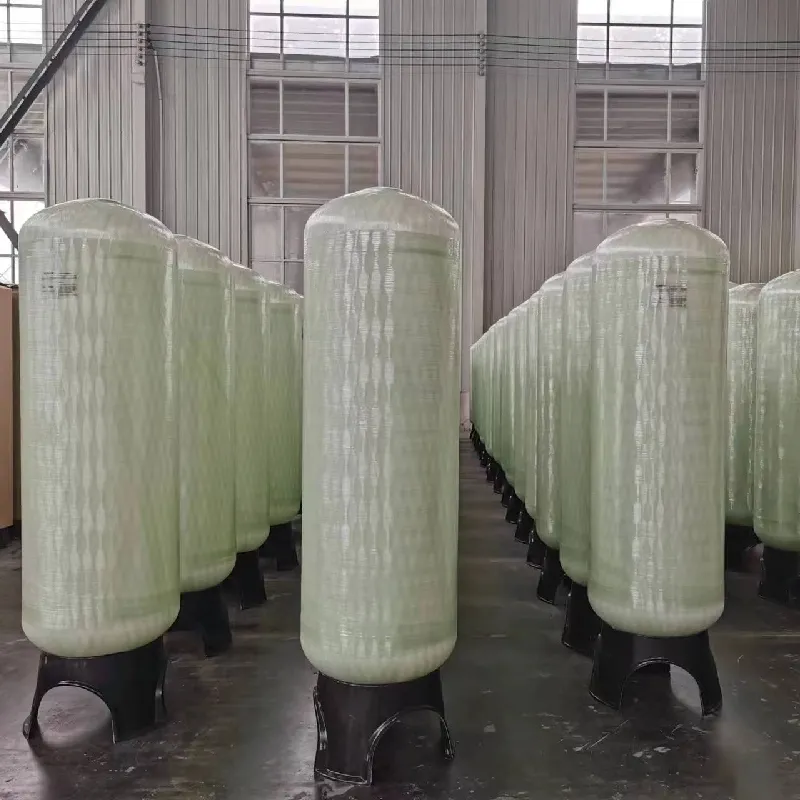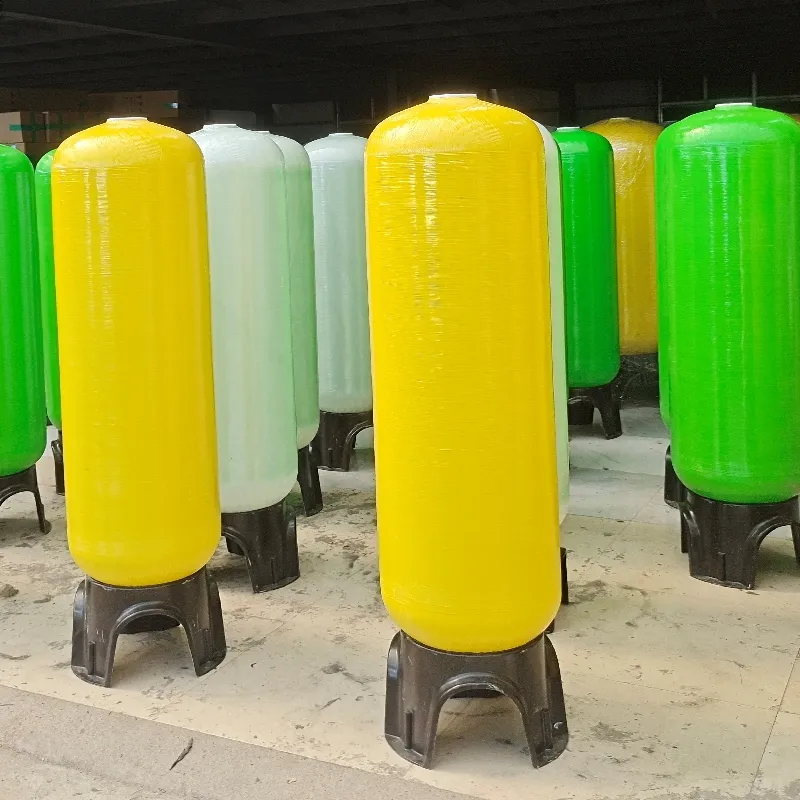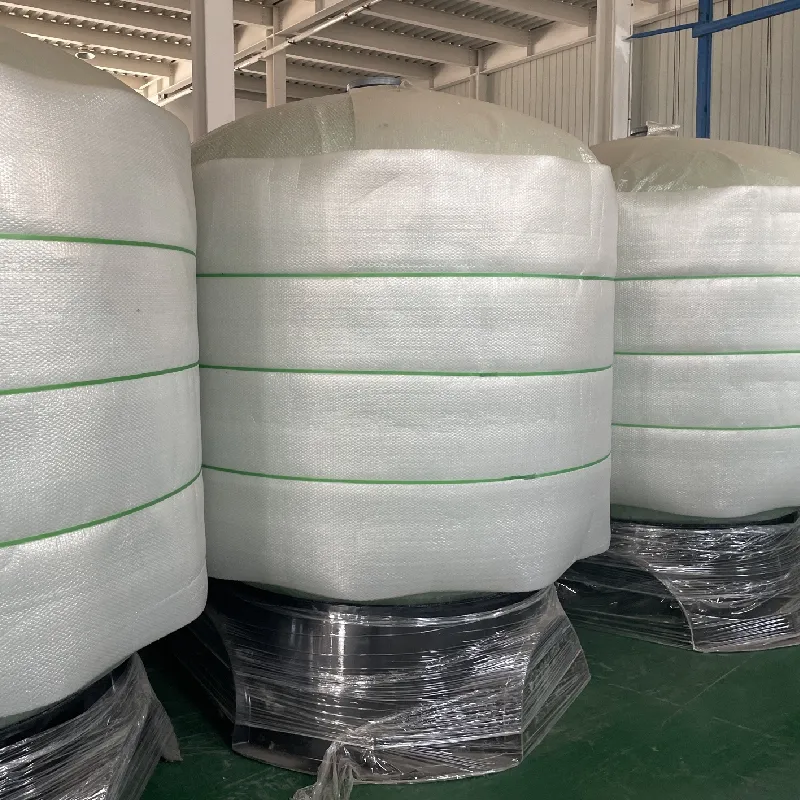loading...
- No. 9, Xingyuan South Street, Dongwaihuan Road, Zaoqiang County, Hengshui, Hebei, China
- admin@zjcomposites.com
- +86 15097380338
- Welcome to visit our website!
Durable FRP Vessels for Water Treatment | Competitive Prices
Understanding FRP Vessels: An Essential Component in Modern Industrial Processes
Fiber Reinforced Polymer (FRP) vessels are indispensable in a myriad of industrial applications due to their exceptional corrosion resistance, high strength-to-weight ratio, and long service life. These composite structures are engineered to safely contain fluids and gases under pressure, making them a critical component in demanding environments where traditional materials often fail. Our focus today is on the advancements and critical considerations surrounding frp vessels, particularly those designed with an HDPE inner lining for food-grade water filtration, such as the Composite Food Grade Pressure Vessel With HDPE Inner For Water Filter.
The industry for frp vessels is experiencing robust growth, driven by increasing demand from sectors like water treatment, chemical processing, and oil & gas. This growth is fueled by a global emphasis on sustainable infrastructure, operational efficiency, and stringent safety standards. Key trends include the development of advanced composite materials offering enhanced mechanical properties, improved manufacturing techniques for greater cost-effectiveness, and the integration of smart monitoring systems for predictive maintenance. This evolution ensures that FRP technology remains at the forefront of industrial containment solutions.
The Meticulous Manufacturing Process of FRP Vessels
The production of high-performance frp vessels is a sophisticated multi-stage process, demanding precision and adherence to strict quality protocols. Our Composite Food Grade Pressure Vessels, for instance, utilize an advanced filament winding technique combined with a robust HDPE inner liner, ensuring both structural integrity and media purity.
Detailed Process Flow:
- Liner Preparation: The process begins with the extrusion or blow molding of an inner liner, typically made from High-Density Polyethylene (HDPE) for food-grade applications. This liner acts as a critical corrosion barrier, preventing direct contact between the contained fluid and the composite layers, and ensuring compliance with standards like FDA.
- Mandrel Setup: The HDPE liner is precisely mounted onto a rotating mandrel, which serves as the form around which the composite layers will be wound. This ensures the correct vessel geometry and dimensional accuracy.
- Filament Winding: This is the core manufacturing process. Continuous glass or carbon fiber rovings, pre-impregnated with a thermosetting resin (e.g., epoxy, polyester, vinylester), are robotically wound around the rotating HDPE-lined mandrel in carefully controlled patterns. The winding angles and tension are critical to achieve the desired mechanical strength, pressure rating, and stress distribution.
- Curing: Once winding is complete, the entire structure undergoes a controlled curing process in an oven. This polymerization reaction transforms the liquid resin into a solid, rigid matrix, bonding the fibers together and giving the vessel its final structural properties. Temperature and time profiles are meticulously managed.
- Demolding: After curing, the FRP vessel is removed from the mandrel. The HDPE liner remains permanently bonded to the composite shell.
- Finishing & Port Integration: Ports, flanges, and other fittings are carefully installed and sealed. External coatings for UV protection or aesthetic purposes may also be applied.
- Quality Control & Testing: Each vessel undergoes rigorous testing. This includes hydrostatic pressure testing to verify burst strength and leak integrity, ultrasonic testing for delamination detection, and visual inspections for surface defects. Adherence to international standards such as ASME, ISO, and ANSI is paramount, ensuring a service life typically exceeding 10-15 years under specified conditions.
The use of high-grade materials and advanced manufacturing techniques results in FRP vessels that offer significant advantages:
- Superior Corrosion Resistance: Impervious to a wide range of chemicals, acids, and bases, unlike metallic vessels.
- Lightweight: Significantly lighter than steel, reducing installation costs and structural support requirements.
- Long Service Life: Reduced maintenance and replacement cycles due to inherent durability.
- Energy Saving: Better insulation properties compared to metal, potentially reducing energy costs for temperature-controlled processes.

Technical Specifications and Performance Parameters
The performance of FRP vessels is defined by a range of critical technical specifications, which are vital for engineers and procurement specialists to ensure optimal system integration and operational safety. These parameters often adhere to stringent international standards, underscoring the product's reliability and compliance.
Typical FRP Vessel Specifications (Example: Water Treatment Series)
These specifications highlight the robust engineering behind FRP vessel design, offering reliable performance under specified operating conditions. The inherent flexibility in manufacturing allows for a wide range of sizes and pressure ratings to meet diverse industrial needs.

Diverse Application Scenarios and Technical Advantages
The versatility and superior properties of frp vessels make them suitable for a broad spectrum of industries and challenging applications. Their ability to withstand corrosive chemicals and operate under various pressures positions them as a preferred choice over traditional metallic alternatives.
Target Industries and Typical Applications:
- Water Supply & Drainage / Water Treatment: This is a primary sector for frp vessel for water treatment. Applications include filtration (sand, carbon, multi-media filters), softening (ion exchange), deionization, and reverse osmosis pre-treatment. The chemical inertness of FRP vessels is crucial for maintaining water purity and resisting the corrosive effects of various water treatment chemicals like chlorine, acids, and alkalis.
- Petrochemical and Chemical Processing: Used for storing and processing aggressive chemicals such as acids (HCl, H2SO4), caustic solutions, and various solvents. FRP excels where stainless steel and other alloys would corrode rapidly.
- Metallurgy & Mining: Applications in acid leaching, electrolyte storage, and wastewater treatment where highly corrosive slurries and solutions are common.
- Food & Beverage: Food-grade FRP vessels, particularly those with HDPE liners, are used for potable water storage, beverage processing, and ingredient storage where hygiene and non-contamination are paramount (e.g., purified water systems).
- Pharmaceutical Industry: High-purity water generation and storage, as well as containment of various pharmaceutical ingredients, demanding strict material purity and sterilization capabilities.
- Power Generation: Demineralized water systems, condensate polishing, and industrial wastewater treatment.
Technical Advantages in Application Scenarios:
- Corrosion Resistance: This is the most significant advantage. In industries handling corrosive media, FRP vessels offer unmatched resistance, drastically reducing maintenance costs and ensuring operational longevity compared to metallic vessels prone to rust and chemical attack.
- Energy Saving: FRP has lower thermal conductivity than metals, contributing to better insulation. This can lead to energy savings in processes where maintaining specific fluid temperatures is essential, reducing the need for extensive external insulation.
- High Strength-to-Weight Ratio: Facilitates easier transportation, installation, and requires less robust structural support, saving on construction costs. For example, a large FRP tank can be lifted and positioned with smaller cranes than a comparable steel tank.
- Durability and Long Service Life: Designed for decades of service, even in harsh conditions. Reduced downtime for repairs or replacements translates into higher productivity.
- Chemical Purity (HDPE Lined): For applications like food and pharma, the inert HDPE liner prevents leaching and contamination, ensuring product integrity and compliance with stringent health regulations.

Vendor Comparison, Customization, and Cost Considerations
Selecting the right supplier for frp vessels is as critical as understanding the technology itself. Factors like manufacturing expertise, adherence to standards, customization capabilities, and after-sales support significantly impact long-term operational success and total cost of ownership.
Key Factors for Vendor Comparison:
- Certifications & Compliance: Verify adherence to industry standards (ASME, ISO 9001, NSF/ANSI 61, FDA). A vendor with robust certifications demonstrates commitment to quality and safety.
- Manufacturing Technology: Assess the sophistication of their production methods (e.g., automated filament winding vs. hand lay-up) for consistency and quality.
- Experience & Reputation: Years in business, project portfolio, and customer testimonials provide insights into reliability and expertise.
- Customization Capabilities: The ability to tailor vessel dimensions, pressure ratings, nozzle configurations, and liner materials to specific project requirements.
- Technical Support & Warranty: Comprehensive pre-sales consultation, engineering support, and a clear warranty policy are indicators of a trustworthy partner.
Customized Solutions: Tailoring FRP Vessels to Exact Needs
One of the significant advantages of FRP technology is its inherent flexibility for customization. Manufacturers can engineer vessels to precise specifications, optimizing them for unique operational demands. This includes:
- Dimension & Volume: From small laboratory vessels to large industrial tanks.
- Pressure & Temperature Ratings: Engineered for specific operational envelopes.
- Liner Materials: Selection based on chemical compatibility (HDPE for food-grade, PVDF for strong oxidizers, etc.).
- Nozzle & Manway Configurations: Optimized for integration with existing piping and equipment.
- External Features: UV inhibitors, specific color requirements, ladder clips, lifting lugs.
Understanding FRP Vessel Price: Factors Influencing Cost
The frp vessel price is influenced by several factors. While initial investment might be comparable or slightly higher than some metallic options, the total cost of ownership (TCO) often favors FRP due to reduced maintenance and longer lifespan.
- Size and Capacity: Larger vessels naturally incur higher material and manufacturing costs.
- Pressure Rating: Higher pressure designs require more robust construction and material, increasing costs.
- Liner Material: Specialized liners (e.g., PVDF, Epoxy Novolac) for aggressive chemicals are more expensive than standard HDPE.
- Number and Type of Fittings: More complex nozzle arrangements and specialty fittings add to the cost.
- Certifications & Testing: Vessels requiring specific certifications (e.g., ASME, PED) often involve additional design, inspection, and documentation costs.
- Customization Complexity: Highly bespoke designs will naturally be more expensive than standard off-the-shelf units.
- Transportation & Installation: While lighter, specific handling and installation requirements can factor into the overall project cost.
Real-world Application Case Studies and Customer Experience
The practical success of FRP vessels is best illustrated through real-world applications where they have demonstrably improved operational efficiency and longevity.
Case Study 1: Municipal Water Treatment Plant Upgrade
A large municipal water treatment plant faced recurring issues with corrosion in their steel filter vessels due to aggressive chlorination and varying pH levels. This led to frequent maintenance, costly downtime, and concerns about water quality. They opted to replace 20 existing steel vessels with custom-designed frp vessel for water treatment with an HDPE inner liner.
- Solution: 60-inch diameter, 100 psi rated FRP vessels, specifically engineered for multi-media filtration and certified to NSF/ANSI 61.
- Results: After five years of operation, zero instances of internal corrosion were reported. Maintenance costs for the filtration units dropped by over 70%, and the plant experienced uninterrupted service, ensuring consistent potable water supply for the community. The lighter weight of FRP also reduced installation time by 25%.
Case Study 2: Chemical Plant Acid Storage
A specialty chemical manufacturer needed to expand its capacity for storing highly concentrated hydrochloric acid (HCl). Their existing lined steel tanks required costly annual inspections and had a limited lifespan.
- Solution: A series of 8-foot diameter, 30-foot tall custom FRP storage tanks with a specialized vinylester resin system and an internal PVDF liner for enhanced chemical resistance against HCl.
- Results: The FRP tanks were installed rapidly due to their lighter weight. The plant reported significant cost savings from eliminating annual internal lining inspections and repairs, with the FRP tanks projected to last twice as long as the previous steel tanks, greatly improving operational reliability and safety.
These cases exemplify how FRP vessels deliver tangible benefits in challenging industrial settings, reinforcing their value proposition for B2B decision-makers.
Frequently Asked Questions (FAQ) about FRP Vessels
To further enhance understanding and trust, here are answers to commonly asked questions about FRP vessels.
Q1: What is the primary advantage of FRP over stainless steel?
A1: The primary advantage is superior corrosion resistance, especially against a wide range of aggressive chemicals, acids, and bases. FRP is also significantly lighter, reducing transport and installation costs, and offers better thermal insulation properties. While stainless steel has its place, FRP excels in highly corrosive environments where metals would rapidly degrade.
Q2: Are FRP vessels safe for potable water applications?
A2: Yes, when manufactured to specific standards. Our Composite Food Grade Pressure Vessel With HDPE Inner For Water Filter, for example, features an HDPE liner and complies with NSF/ANSI 61 and FDA requirements, ensuring no leaching of contaminants into the water. Always verify certifications for food-grade or potable water use.
Q3: What is the typical service life of an FRP vessel?
A3: A well-designed and properly maintained FRP vessel can have a service life of 15-20 years or more. Factors like operating conditions (temperature, pressure, chemical concentration), proper installation, and adherence to maintenance schedules can influence this lifespan.
Q4: How does the frp vessel price compare to traditional materials?
A4: Initial costs for FRP vessels can be competitive with or slightly higher than standard steel, but often lower than exotic alloys. However, when considering the total cost of ownership (TCO), FRP vessels typically offer significant savings due to lower installation costs, reduced maintenance, and a longer operational lifespan in corrosive environments, negating the need for frequent replacements or expensive linings.
Lead Time, Warranty, and After-Sales Support
For B2B clients, logistical considerations and ongoing support are as crucial as product quality. We are committed to transparency and reliability across all aspects of our service.
Lead Time and Fulfillment:
Our standard lead time for typical FRP vessels ranges from 4 to 8 weeks, depending on customization complexity, size, and order volume. Expedited options may be available upon request. We maintain efficient production schedules and robust supply chain management to ensure timely delivery, minimizing project delays for our clients. Project-specific lead times are always confirmed during the quotation process.
Warranty Commitments:
All our FRP vessels come with a comprehensive 5-year limited warranty against manufacturing defects and material failures under normal operating conditions. This commitment reflects our confidence in the quality and durability of our products, providing peace of mind for our industrial partners. Detailed warranty terms are provided with each purchase agreement.
Customer Support and After-Sales Service:
Our dedication extends beyond delivery. We offer full-spectrum after-sales support, including:
- Technical Assistance: Expert guidance on installation, operation, and troubleshooting.
- Spare Parts: Availability of essential spare parts and accessories to ensure continuous operation.
- Maintenance Advice: Recommendations for routine maintenance to maximize vessel lifespan and performance.
- Responsive Communication: A dedicated support team reachable via phone and email to address inquiries promptly.
Certifications and Authoritative References
Our commitment to quality and safety is underpinned by adherence to stringent international standards and certifications, providing our clients with absolute confidence in our FRP vessel solutions.
Key Certifications:
- ISO 9001: Certified Quality Management System ensuring consistent product quality and customer satisfaction.
- NSF/ANSI 61: For components used in drinking water systems, affirming product safety for potable water applications.
- FDA Compliance: Inner liner materials, such as HDPE, meet U.S. Food and Drug Administration (FDA) regulations for food contact materials, critical for food and beverage processing.
- ASME Section X: For specific pressure vessel designs, indicating compliance with the American Society of Mechanical Engineers' boiler and pressure vessel code.
- PED (Pressure Equipment Directive) 2014/68/EU: For vessels supplied to the European market, ensuring compliance with essential safety requirements.
These certifications are a testament to our rigorous testing, quality control, and engineering excellence, establishing our authority and trustworthiness in the composite vessel industry.
Conclusion: The Future of Industrial Containment with FRP Vessels
FRP vessels represent a cornerstone technology for modern industrial processes, offering unparalleled corrosion resistance, lightweight construction, and extended service life. Their adaptability, especially with specialized liners like HDPE for food-grade applications, makes them an optimal choice across demanding sectors such as water treatment, chemical processing, and food & beverage.
As industries increasingly prioritize sustainability, operational efficiency, and safety, the demand for advanced composite solutions like frp vessels will continue to grow. Partnering with a reputable manufacturer committed to quality, customization, and comprehensive support ensures that your investment in FRP technology yields maximum long-term value and operational excellence.
References
- ASM International. (2001). Engineered Materials Handbook: Volume 1, Composites. ASM International.
- American Society of Mechanical Engineers (ASME). (2021). Boiler & Pressure Vessel Code, Section X: Fiber-Reinforced Plastic Pressure Vessels. ASME.
- NSF International. (2023). NSF/ANSI/CAN 61: Drinking Water System Components – Health Effects. NSF International.
- Food and Drug Administration (FDA). (2023). Title 21 Code of Federal Regulations, Part 177: Indirect Food Additives: Polymers. U.S. FDA.
- European Commission. (2014). Directive 2014/68/EU on Pressure Equipment. Official Journal of the European Union.
-
Revolutionizing Industrial Safety with ZJ Composites' Mini Mesh GratingNewsNov.14,2025
-
Premium FRP Profiles and FRP Grating Revolution for Global WholesalersNewsNov.14,2025
-
Ultimate Strength with ZJ Composites FRP Profiles for Wholesale SuccessNewsNov.14,2025
-
ZJ Composites Covered Grating – The Durable Flooring Solution for Smarter Industrial SpacesNewsNov.14,2025
-
Mini Mesh Grating Enhancing Strength and Style in Every ProjectNewsNov.14,2025
-
FRP Pressure Vessels by ZJ CompositesNewsNov.14,2025
-
Transforming Industrial Spaces with Advanced Frp GratingNewsNov.11,2025
